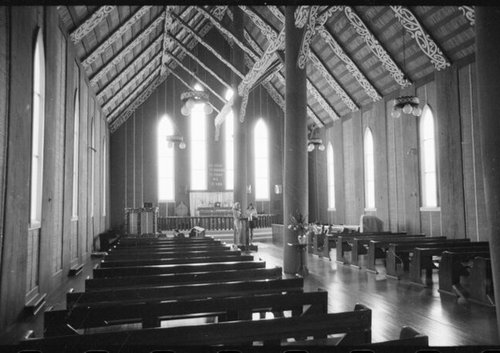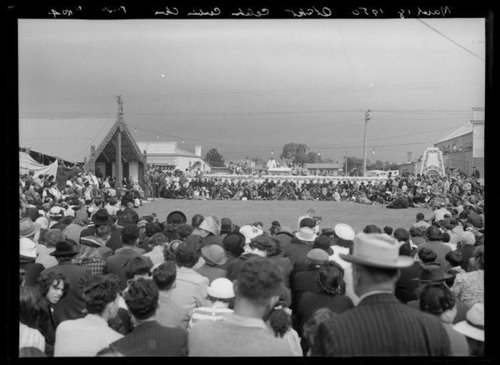
Reflections on the first 100 years of Ōtaki’s iconic Rangiātea Church were beautifully captured in two audio recordings of the thanksgiving ceremony held at the church on 18 March 1950. The occasion marked the centenary of the church’s opening and also acknowledged the recent restoration work that had taken place.
This item demonstrates the ability of archival recordings to take the listener to a particular moment. It is very intimate – parishioners can be heard shuffling, rising and sitting down, and letting out small coughs during the service. Speakers included Governor General Sir Bernard Freyberg, Sir Apirana Ngata and the Bishop of Aotearoa, Frederick Augustus Bennett, who all praised the vision and design of the church.
Part 1
Bennett led much of the service and delivered the sermon in which he paid tribute to the people responsible for its creation. Out of the many who contributed, particularly noted were Octavius Hadfield who inspired the community to build it; Samuel Williams who planned it; and ‘the great rangatira’ Te Rauparaha and Ngāti Raukawa for the material and labour.
Following his 1846 imprisonment, Te Rauparaha was released in Ōtaki and is quoted as saying ‘Take this weapon – I no longer survey the land; I shall survey the heavens. Build a church for us all’. He worked with Hadfield to achieve this vision. Bennett noted that the church’s construction symbolises the wishes of Māori and non-Māori to live together in peace and that the building itself weaves Māori and Christian traditions.
This combination is demonstrated throughout the recording, with thanks being given in both English and te reo Māori, and the Lord’s Prayer being recited simultaneously in both languages (at 6:55).
Apirana Ngata reads the lesson in English and te reo and is followed by Bennett’s sermon. The Bishop reflects how the church is named not after saints or apostles but Rangiātea – part of the ancestral homeland of Hawaiki. ‘Māori have united aspects of their mythology with Christianity,’ notes Bennett who also discusses the whakatauki; ‘We shall not die for we have come from the seed planted in Rangiātea’.
Governor General Freyberg then speaks, presenting a gift from King George VI of an altar frontal.

Rangiātea Church Centenary by Sydney Charles Smith. Courtesy Kete Horowhenua.
Part 2
In the second part of the recording, the ceremonies move to Raukawa Marae and Freyberg reflects on the significant contributions of the 28th Māori Battalion. He also gives personal anecdotes of playing football 40 years earlier with members of the Winiata, Tahiwi and Parata whānau.
Bishop Bennett describes how he met the King on a number of visits to Buckingham Palace and humbly asked for a gift for the Māori people. The frontal incorporates motifs made by singer, carver and artist Inia Te Wiata – famous son of Ōtaki. It also combined part of an earlier frontal gifted from Queen Victoria, connecting her legacy with that of her mokopuna George VI.
The recording ends with cultural performances of kapa haka, poi and choral singing. The performance groups were competing for a Centennial Memorial Shield that had been donated by Canon Paora Temuera of Rangiātea Church.
Afterwards
Just months after this recording, two prominent speakers passed away. This is the last known recording of Apirana Ngata, who died in July 1950; Frederick Bennett passed away in September. He served as the first Bishop of Aotearoa, a role established in 1928. He ministered to all Māori though the role initially lacked a specific territorial jurisdiction. One of Bennett’s 19 children, Manuhuia, became the third Bishop of Aotearoa in 1968.
Rangiātea was destroyed by arson in 1995 but was faithfully rebuilt and reopened in 2003. This recording speaks to the nature of time – we can listen back to this 1950 recording, which captures the community looking back to 1850 and looking forward to their future with the church.